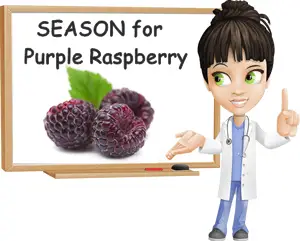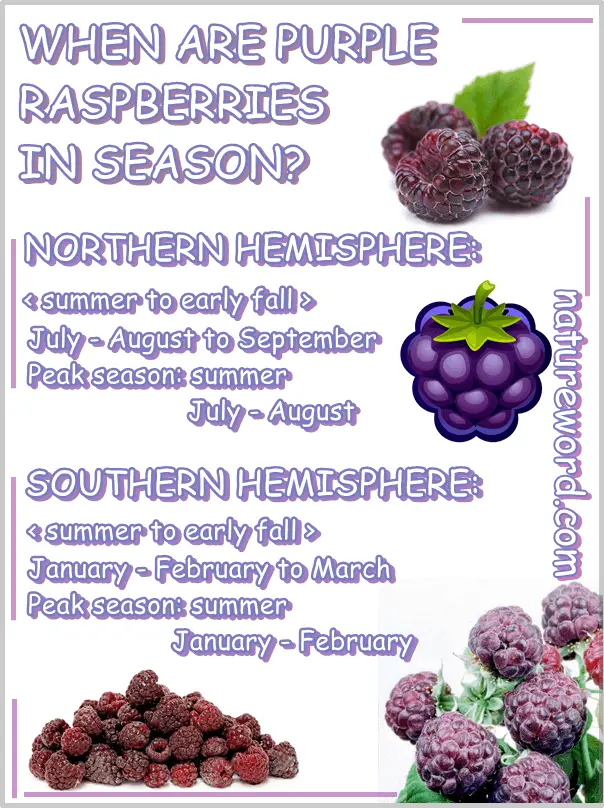Purple raspberries are a seasonal summer fruit and like all seasonal summer fruits they are in season in summer. But when exactly is purple raspberry season? What months are purple raspberries in season? When does purple raspberry season start and end? How long does purple raspberry season last?
What are purple raspberries?
As their name aptly suggests, purple raspberries are a variety of raspberry that is purple instead of the more typical red color. Aside from the difference in color, purple raspberries also taste differently from red raspberries and boast additional benefits for health as a result of their particular color. There are actually different varieties of purple raspberries ranging in color from a deep reddish purple to deep red with faint purple notes (wine color) or a darker purple color with bluish tones.

Where do purple raspberries come from?
Purple raspberries are a cross between red and black raspberries. Raspberries are known to hybridize easily and a red and black raspberry plant can cross and naturally create a purple raspberry plant.
While purple raspberries can be obtained by the intentional crossing of red and black raspberries, they can also occur naturally, without any human intervention at all, as proven by their unassisted occurrence in the wild.
Because they are the result of a natural hybridization process that does not involve genetical engineering, purple raspberries qualify as a naturally occurring plant species and are non GMO.
It’s possible to end up with a purple raspberry plant if you grow red and black raspberry shrubs too close together.
When is purple raspberry season?
Purple raspberries are in season at the same time as red raspberries and other raspberry colors: summer through early fall. Depending on the region of cultivation, climate and variations in yearly weather conditions, peak harvest season may be July – August in the Northern hemisphere and January – February in the Southern hemisphere. However, there are a few observations to make with regards to the seasonality and availability of the raspberry color.

One: purple raspberries are not cultivated as extensively as the dominant variety, red raspberries, not to mention they occur as a commercial crop in a limited number of regions. So while they are naturally in season summer through early fall, their season in certain areas may actually be much shorter due to the lack of cultivation translating into a lack of supply.
Two: purple raspberry season differs in duration, start and end between different regions of cultivation according to climate and weather conditions. The season may also fluctuate depending on yearly variations in temperature and other weather conditions. As a result, the purple berries may be in season for as little as a month and up to two months or more per hemisphere, with shifts in the start and end of the natural season.
Three: there are different types of purple raspberries. One type bears fruit just once per season, usually in the middle of the summer, while the other bears fruit two times per season, in summer and fall (the latter is called everbearing). The type of purple raspberry cultivar planted will determine season length in a region.
When is purple raspberry season in the Northern hemisphere?
In the Northern hemisphere purple raspberries are in season summer through early fall, with peak season being July-August. Depending on the region, the harvest season can start at the beginning of July or later, in August, and end either a month later or last until late September to early October at the latest.
When is purple raspberry season in the Southern hemisphere?
In the Southern hemisphere purple raspberries are also in season summer to early fall. However, because the seasons are reversed, that means that purple raspberries are in season at opposite times during the year in the Southern hemisphere.
The first purple raspberries are ripe and ready to pick sometime in December, but the harvest season is at its peak January through February. Purple raspberries may be available as fresh fruit throughout March, but qualify as late-season.
By comparison, the harvest season for yellow raspberries starts mid to late June at the earliest and lasts until mid to late September at the latest, early October in rare cases if weather conditions are extremely favorable.
Blackberries and blueberries are available more abundantly, late spring to early fall. Find out more about when is blackberry season and when is blueberry season. Red and black mulberries are also seasonal summer fruit and available at the same time as purple raspberries.
Purple raspberry season by month
In the Northern hemisphere, purple raspberries are in season in the months of July and August and all throughout September if the climate and weather in the region of cultivation allow for such an extended harvest season.
Purple raspberries season by month in the Northern hemisphere
- Peak season: July or August or July through August
- Late season: September
In the Southern hemisphere, purple raspberries are in season in the months of January and February and throughout March, again, if the climate and weather conditions specific to the region of cultivation allow for it.
Purple raspberries season by month in the Southern hemisphere
- Peak season: January and February or January through February
- Late season: March
How long does purple raspberry season last?
On average, purple raspberry season is shorter than red raspberry season and even yellow raspberry season.
Purple raspberries may be in season for as little as one month to two months or slightly more depending on the region of cultivation, how large it is, how many climates it covers, weather conditions and how extensively the variety is cultivated in said region.
While peak season for the raspberry color is summer, July-August in the Northern hemisphere and January-February in the Southern hemisphere, de facto, the raspberries may only actually be available for about one month (e.g. July or August in the Northern hemisphere).
Despite the potential for a relatively long natural season, the poor presence in commercial cultivation of purple raspberries makes it so that their season is simply shorter. Plants do not produce fruits continuously throughout their natural season, but rather one or two crops per season, one being more likely
Also, the berries get harvested gradually, as they ripen, over the course of 4 to 6 weeks tops. Once the harvesting period is completed, the season ends, and harvesting usually only spans over one month to two months tops, taking in account different cultivars that may bear fruit earlier or later in the season.
